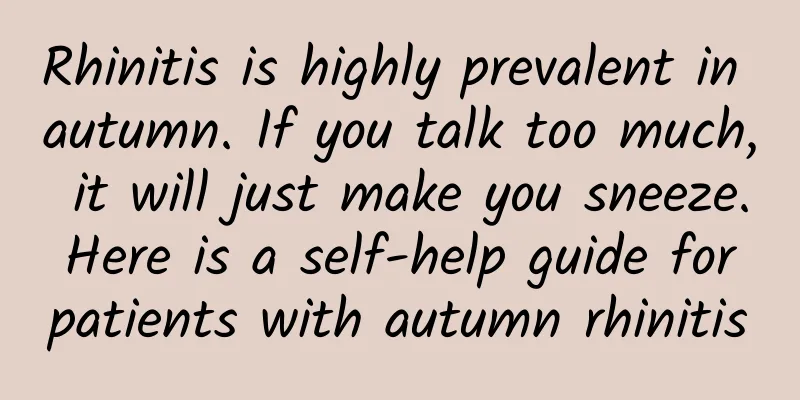Rhinitis is highly prevalent in autumn. If you talk too much, it will just make you sneeze. Here is a self-help guide for patients with autumn rhinitis

|
In autumn, the temperature difference is large, the weather is dry, and the dust mites and pollen in the air increase, which can easily lead to rhinitis. When rhinitis occurs, patients often have long-term runny nose and sneezing, which seriously affects their daily study and life. So, how can patients with rhinitis spend the autumn smoothly? Rhinitis is an inflammation of the nasal mucosa caused by viruses, bacteria, allergens, various physical and chemical factors, and certain systemic diseases. Rhinitis is divided into allergic rhinitis and non-allergic rhinitis. Allergic rhinitis is usually caused by allergens, and the severity of symptoms fluctuates with the seasons. Once patients with allergic rhinitis come into contact with allergens, they will develop symptoms of allergic rhinitis. There are many causes of non-allergic rhinitis, which usually exist all year round, including atrophic rhinitis, drug-induced rhinitis, senile rhinitis, etc. The main symptoms of rhinitis are nasal itching, sneezing, runny nose and nasal congestion, etc. The symptoms of sneezing and runny nose are most severe in the morning after waking up. Both allergic rhinitis and non-allergic rhinitis patients will experience nasal congestion, sneezing and runny nose, but allergic rhinitis patients often have itchy eyes or skin due to allergies, while non-allergic rhinitis patients often do not have this symptom. For patients with allergic rhinitis, staying away from allergens is an effective way to prevent the onset of rhinitis. The most common allergen is pollen. Pollen allergy has obvious seasonality and often occurs in spring and autumn. Indoor allergens often include dust mites, animal hair, fungi, cotton wool, and some food allergens. In addition, there are some unknown factors that can also induce allergies, such as temperature changes and endocrine disorders. If you find that you have allergic symptoms, you can first go to the hospital for an allergen skin test and serum-specific test to identify the allergens, and then be careful to stay away from things or foods that make you allergic. Patients who are allergic to dust and dust mites should keep their living environment clean and dry, ventilate well, and wash and dry quilts and clothes regularly [1]. In autumn, the outdoor temperature is low. Patients with rhinitis should pay attention to reducing the irritation of the nasal cavity caused by cold and dryness. Wear a mask when going out and try to avoid going to public places. Maintain the humidity of the indoor air to prevent the nose from being too dry. Also, open the window frequently for ventilation. Smokers with rhinitis should pay attention to quitting smoking in time, and non-smokers should also pay attention to staying away from second-hand and third-hand smoke [2]. Patients with allergic rhinitis can also clean their nasal cavity appropriately, using saline or some special nasal wash solution to clean the nasal cavity and sinuses, wash away harmful substances such as dust, bacteria, viruses, and some secretions, protect the nasal mucosa, and promote the restoration of the natural swinging function of nasal cilia. Do not pick your nose with your hands at ordinary times, as it can easily damage the nasal mucosa and cause bleeding or inflammation [2]. When rhinitis patients first start to experience symptoms, they may easily think that they have a common autumn and winter cold. When they find that symptoms such as nasal congestion, runny nose, and sneezing do not disappear for a long time, they should be alert to whether it is rhinitis. Do not underestimate this minor disease. If rhinitis is not treated for a long time, it will cause a series of complications. Rhinitis patients should seek medical treatment in time, find the cause of their disease in time, actively treat it, and take good protection and care in daily life. Patients with rhinitis should pay attention to eating more fruits and vegetables, quit smoking and limit alcohol, avoid spicy food, and drink more boiled water. They can also do proper exercise, which can enhance people's resistance and help relieve allergic symptoms. Before exercise, pay attention to warming up to allow the body to gradually adapt to the temperature and humidity of the exercise environment to avoid irritation to the nasal cavity. 1. Chen Peiyi: Prevention and treatment strategies for allergic rhinitis in autumn. Food and Health 2014(10):40-41. 2. Chen Baoli: Prevention and nursing experience of allergic rhinitis. Journal of Qiqihar Medical College 2011(17):2873-2874. |
<<: A different kind of edema - hereditary angioedema
>>: What is ants climbing trees? What are the characteristics of ants climbing trees?
Recommend
Beware of the top ten causes of hair loss
Having black, shiny hair is the wish of all women...
Can women eat durian during menstruation?
Women will have their menstrual period every mont...
What is the reason for less bleeding after abortion?
What is the reason for less bleeding after aborti...
How to protect pregnancy with short cervix
The physical condition of every pregnant woman is...
Can a pregnant woman breastfeed if she has a cold?
After catching a cold, mothers are afraid to brea...
What happens when you take dydrogesterone tablets?
Dydrogesterone can be used for various conditions...
How to check female thyroid gland
Thyroid cyst is a common endocrine disease, which...
Can women drink dandelion water during breastfeeding?
Any behavior or daily diet of a breastfeeding wom...
What is a tidal lane? Can you change lanes in a tidal lane?
Many friends will encounter tidal lanes during th...
How to identify the authenticity of Dayi tea? What does Dayi tea 7572 mean?
Dayi tea is brown-red in color, mellow in taste, ...
What should I do if my period is delayed for five days?
Some female patients have health problems, so fem...
Is it useful to stimulate ovulation in patients with polycystic ovary?
If a woman wants to be a mother, she must undoubt...
How to check if you are pregnant using a pregnancy test stick?
The pregnancy test stick is also called an early ...
How to keep your breasts healthy
Women play an important role in life, but they al...







![[Popular Science Lecture] Treatment options for atrial fibrillation: medication or surgery?](/upload/images/67f1983a9151e.webp)

